Best powerline extenders for 2022
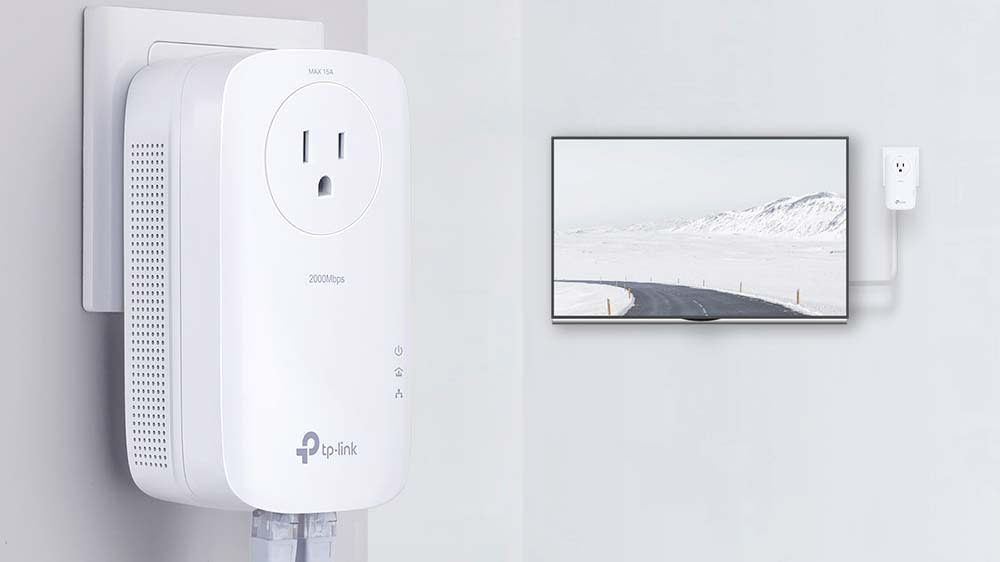
With one of the best powerline extenders, you can easily eliminate Wi-Fi dead spots throughout your home. By using a house’s own electrical cabling, an extender sends signals through the walls to any connected AC outlet. This helps spread the reach of your network to the rooms farthest away from your Wi-Fi router without pumping out more Wi-Fi signals or a mess of cables.
We’ve used and thoroughly tested the top powerline-extender kits in real-world conditions to help you pick the best system for your home. Our criteria emphasize data throughput, signal range and value – including the device’s price, design and electricity consumption – to whether the extender provides an extra AC outlet to compensate for the one it uses.
Using a powerline extender couldn’t be simpler: just plug one of the small boxes into an AC next your router and another receiver where you want the data to end up. There aren’t any passwords, software or configuration processes to fuss with.
On the downside though, the data comes out of a wired Ethernet port. Plus, the farther the signal has to travel, the less data gets through to the receiver. Older homes with complicated wiring may also suffer from reduced range. However, in the typical home, powerline extenders can send signals for about a hundred feet, plenty for people living in an average-sized home. If your home is even larger or oddly shaped, you may want to consider one of the best mesh routers instead.
What are the best powerline extenders?
In our testing, the best powerline extender overall was the Netgear PLP2000, which stood out as superior by delivering the fastest data along with a reasonable range. It should be more than enough to add data where it’s needed.
If you live large, the TP-Link TL-PA9020P is the best powerline extender for large homes. The TP-Link's extended range can help turn a big house into a data-filled home. It has a monitoring and configuration utility, but the device is a power hog and that will show up on your power bill.
Meanwhile, D-Link’s DHP-601AV is the best budget powerline extender. The unit's small size, inexpensive price and power-efficient, two-prong plug design is perfect for homes without grounded three-prong outlets.
The best powerline extenders you can buy today
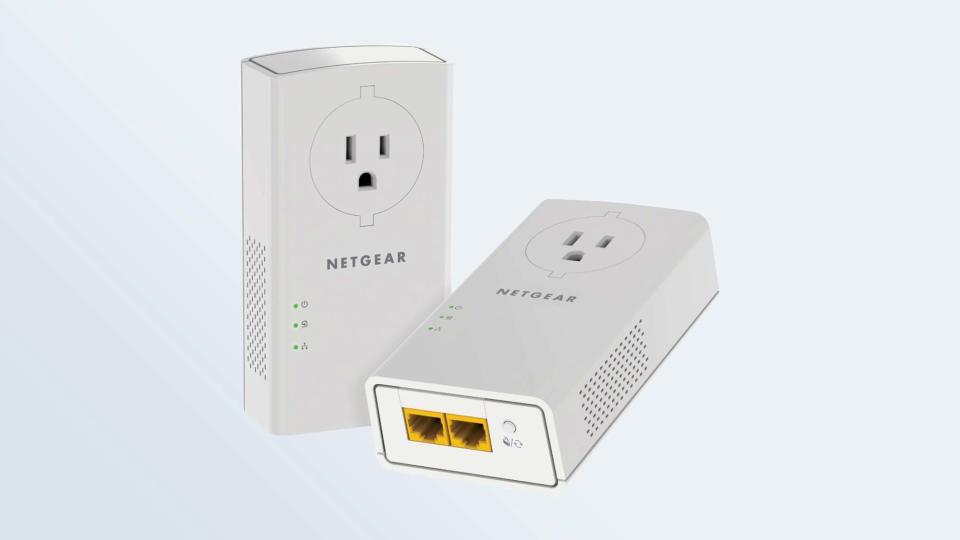
1. Netgear PLP2000
Best powerline extender overall
Max Throughput: 101.0Mbps | Dimensions: 5.3 x 2.8 x 2.3 inches | Connections: Three-Prong AC Plug and Two Ethernet | Range: 775-feet | Wi-Fi: No
Top performance
Two Ethernet ports
Low power use
Expensive
90-days of support
It’s a close call, but the Netgear PLP2000’s superior throughput trumped the TP-Link’s TL-PA9020P’s extended range, making it our choice as the best Powerline adapter. With the ability to move more data, the PLP2000 outperformed the crowd and filled a previously unconnected garage with more than enough data to watch videos, play games and live online.
It may be one of the largest PL extenders available and not include a monitoring utility, but the PLP2000 provides an AC outlet to make up for the one it uses and its two gigabit Ethernet ports provide data for a TV and a computer. While at $110 it’s among the most expensive PL extenders, it includes a one-year warranty and only 90-days of support, while its peers include a year or two of warranty and support.
Netgear’s PLP2000 can push data into unconnected parts of a home at peak performance and is the one to get.
Read our full Netgear PLP2000 Powerline Extender review.
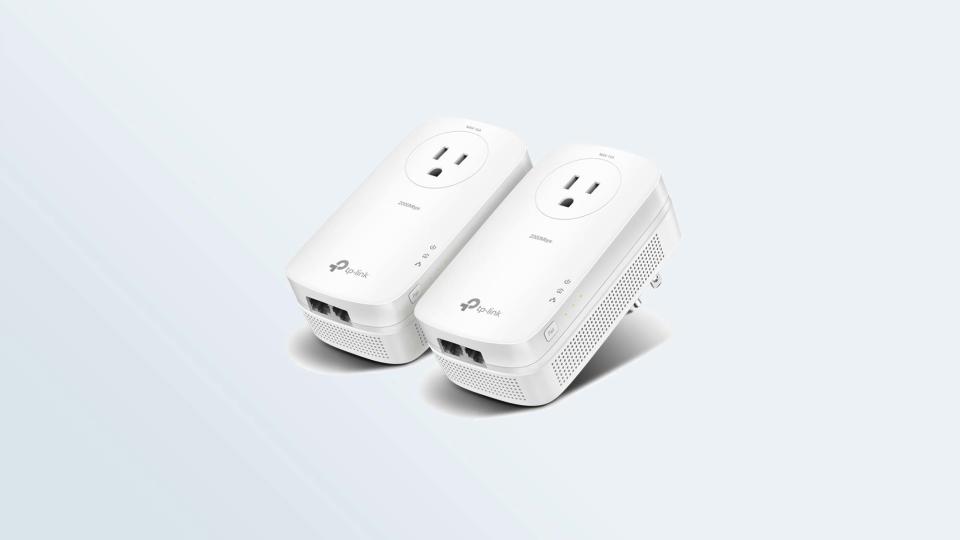
2. TP-Link TL-PA9020P
The best powerline extender for large homes
Max Throughput: 42.9Mbps | Dimensions: 5.2 x 2.8 x 1.9 inches | Connections: Three-Prong AC Plug and Two Ethernet | Range: 1,075-feet | Wi-Fi: No
Excellent range
Two Ethernet ports
Monitoring utility
LEDs on side
High energy use
TP-Link’s TL-PA9020P can help fill a big home with powerline data thanks to its class-leading range. It may be off the blistering pace set by the PLP2000, but the TL-PA9020 has the power to push data through more than 1,000-feet of electrical wiring and delivered top-speed to a previously unconnected garage. Its pair of Ethernet ports and AC passthrough outlet mean that it not only won’t hog your home’s outlets but can supply data to two devices, like a smart TV and a computer.
While its monitoring and configuration utility lets you customize your powerline network by renaming the devices and adjusting the Quality of Service parameters of the TL-PA9020P, its thirst for electricity makes it expensive to use and its side-mounted LEDs can be hard to see. Still, the $90 TL-PA9020P can fill a big home with data.
Read our full TP-Link TL-PA9020P Powerline Extender review.
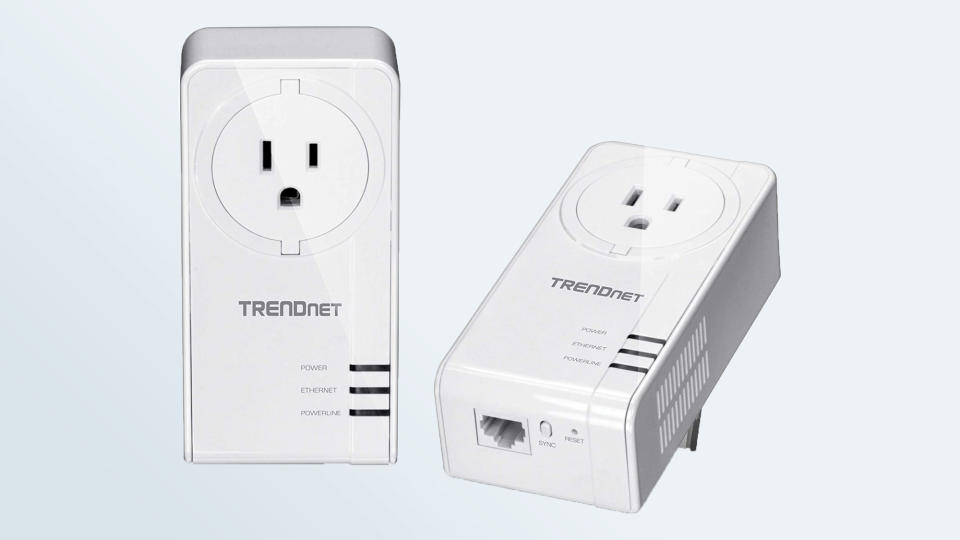
3. Trendnet TPL-423E2K
The best value powerline extenders
Max Throughput: 47.5Mbps | Dimensions: 4.7 x 2.3 x 1.5 inches | Connections: Three-prong AC Pass-Thru and 1 Gbps Ethernet | Range: 581 feet | Wi-Fi: No
Inexpensive with low operating costs
3-year warranty
Includes utility
AC passthrough outlet
Single Ethernet port
Short range
The Trendnet TPL-423E2K is for those who care more about value and a three-year warranty than getting the top performance, extra range or the ability to service two networked devices. Overall, the TPL-423E2K offers the enviable combination of low upfront price and low operating costs, making it the one for penny-pinchers to get.
What the Trendnet TPL-423E2K lacks in speed and range it more than makes up with a handy AC passthrough outlet, a useful utility and a class-leading three year warranty. At $70 for the set, the TPL-423E2K is a must-have for those who choose low costs and reliability over all-out performance in powerline devices. The Trendnet TPL-423E2K offers affordability and the assurance that it will work for years, even if that function doesn't have the range and bandwidth of more expensive competitors.
Read our full Trendnet TPL-423E2K Powerline Extender review.
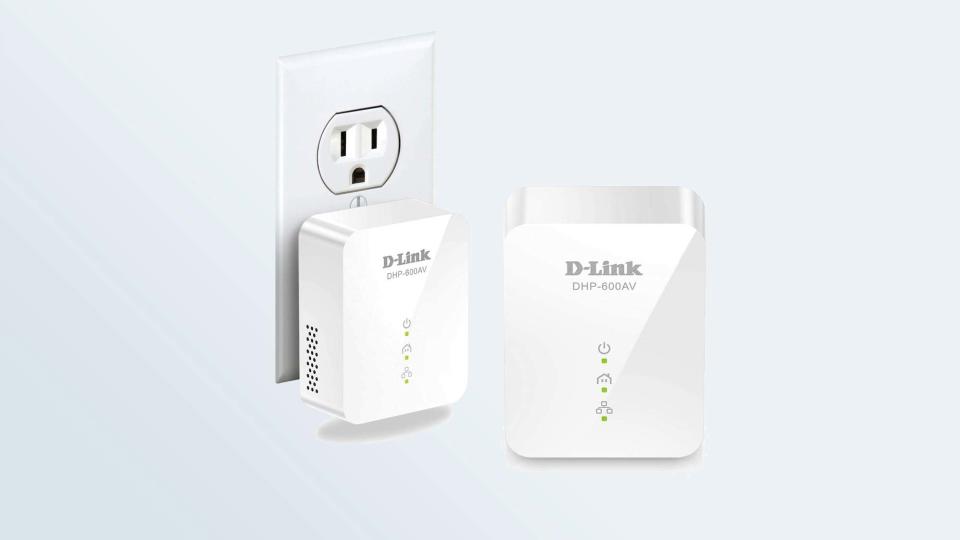
4. D-Link DHP-601AV
The best budget powerline extender
Max Throughput: 43.3Mbps | Dimensions: 2.7 x 2.2 x 1.0 inches | Connections: Two-Prong AC Plug and One Ethernet | Range: 525-feet | Wi-Fi: No
Small
Two-prong AC plug
Inexpensive
Single Ethernet port
Low performance and range
Despite its short range and middling performance, the D-Link DHP-601AV’s two-prong plug can help bring data to older homes that lack ungrounded three-prong outlets. Small and easy to hide, the DHP-601AV has three LEDs to show network status but falls short by lacking an AC passthrough outlet to make up for the one it uses. With a single Ethernet port, a powerline network composed of DHP-601AV units will need a networking switch to connect to more than one device.
Although several competitors provide a monitoring and configuration utility for adjusting the parameters of the powerline network, the DHP-601AV has none. On the other hand, it sips electricity while others gulp it and could cost only $2.40 a year to operate. That, along with its $60 price tag, means the DHP-601AV is cheap to keep for an older home.
Read our full D-Link DHP-601AV Powerline Extender review.
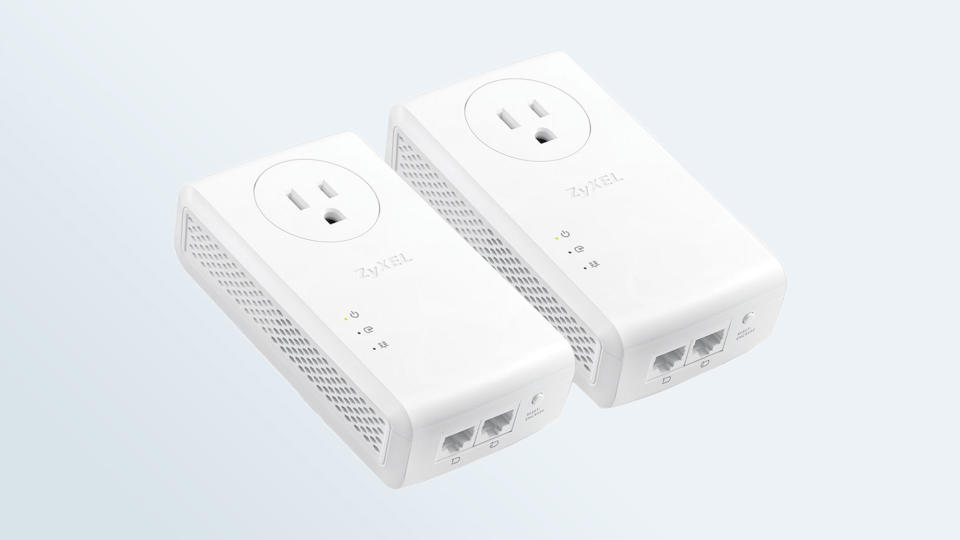
5. Zyxel PLA5456
A good basic extender
Max Throughput: 54.0Mbps | Dimensions: 5.2 x 2.8 x 1.7 inches | Connections: Three-prong AC Pass-Thru and 2 Gbps Ethernet | Range: 750 feet | Wi-Fi: No
Pair of Ethernet ports
AC passthrough outlet
Monitoring utility
2-year warranty
Large
Lacks effective power conservation
The Zyxel PLA5456 is big and combines a pair of Ethernet ports with a useful monitoring utility and a handy AC passthrough outlet. It will help push data throughout your home, but it's big, and delivers adequate (if unexceptional) performance and range. It’s no bargain for the two devices, but the PLA5456 is for buyers looking for a powerline extender that quietly does its work behind the scenes.
Provided you don't need the better performance required for uses like streaming video or gaming, the Zyxel might be a good fit for homes with less-intensive data needs. The shorter range and limited bandwidth are enough to support basic online activities like web browsing and social media, but are unimpressive compared to our top models. Nonetheless, the design offers some convenience with it's added AC outlet, and sales prices could still make the Zyxel a smart buy.
Read our full Zyxel PLA5456 powerline extender review.
Do you need a powerline extender?
Powerline extenders offer a discreet way to replace long lines of Ethernet cable with the electric wiring that’s already in your walls. This makes them a great option for anyone that wants to stretch their network connectivity to new rooms and rid their home of Wi-Fi dead spots. But is a powerline extender right for you?
There are two other options worth considering when you want to get better connectivity in the furthest reaches of your home. The first is a signal booster, like those in our guide on the best Wi-Fi extenders, which can capture and rebroadcast a wireless signal to help boost the reach of your Wi-Fi router. That’s a perfectly good option when you have continuous Wi-Fi between the router and the extender. If a far room shares electric wiring with your router but
the Wi-Fi signal from your router doesn’t reach far enough for a wireless extender, then a powerline extender is the better choice.
Find out more in our article Wi-Fi extenders vs powerline adapters: Everything you need to know.
The other alternative is upgrading to a mesh Wi-Fi system which uses multiple units to provide a single seamless Wi-Fi network that can easily cover even the largest homes with a strong wireless signal. However, the switch from a standard router to one of the best mesh Wi-Fi routers can be expensive. If you want to stretch your network without paying a few hundred dollars, it’s worth trying a powerline extender first.
How we test powerline extenders
To evaluate each of the powerline extenders we review, we test each in a variety of ways. In addition to price and physical design, we also take a closer look and test their throughput, range and bandwidth over distance as well as temperature and power consumption.
Throughput: To measure the range of each powerline set, we plugged the sending unit in at a home’s circuit breakers and the broadband modem and the receiver at an AC outlet 10-feet away.
Wired Range: After measuring throughput, we added a series of 100-foot grounded extension cords and measured the available bandwidth. With the system disconnected, we removed the last cord and added 50-, 25-, 12- and up to two 6-foot cords. The range is the total length of the extension cords that delivered the lowest throughput without disconnecting.
Bandwidth: We also set up the receiver in a garage that’s about 100-feet from the sending unit and measured the bandwidth. We finished this round of testing by watching HD videos, playing games online and visiting a number of websites.
Temperature and Power Consumption: While watching videos we measured each device’s peak temperature with a Fluke 62 mini IR thermometer. We also measured power consumption (both in use and while idle) using a Kill A Watt Edge power meter. Assuming the gear is active half of the day and sits idle for the rest, we multiplied each power-use figure by 4,380 (365 days times 12 hours a day) and added the results together. Then, we doubled the total for the two devices needed and divided by 1,000 to get the annual energy use in kilowatt-hours. Finally, we multiplied this by $.13 (the average price of a kilowatt-hour) to get our estimate of annual operating cost.
Behind the scenes, we used a Linksys WRT32X router, a 200Mbps Internet connection, a Lenovo ThinkPad T470 notebook and the Speedtest app to measure throughput. For all testing, five data points were averaged.
Check out all of our home networking coverage:
Best Wi-Fi routers | Best mesh routers | Best Wi-Fi 6 routers | Best gaming routers | Best Wi-Fi extenders | Best cable modems

